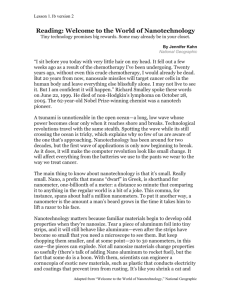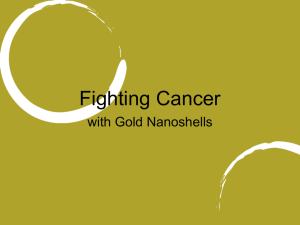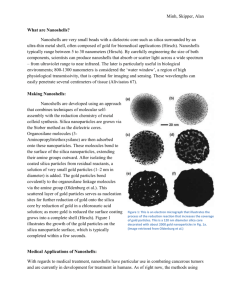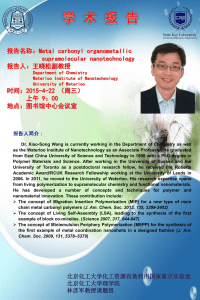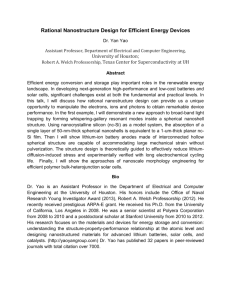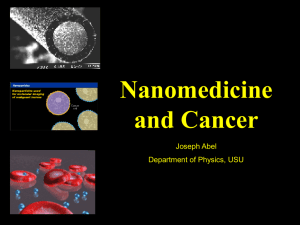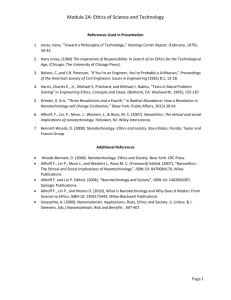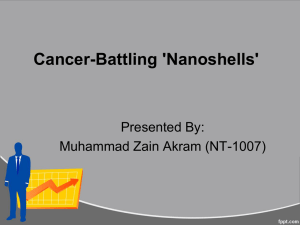NANO - University of Pittsburgh
advertisement
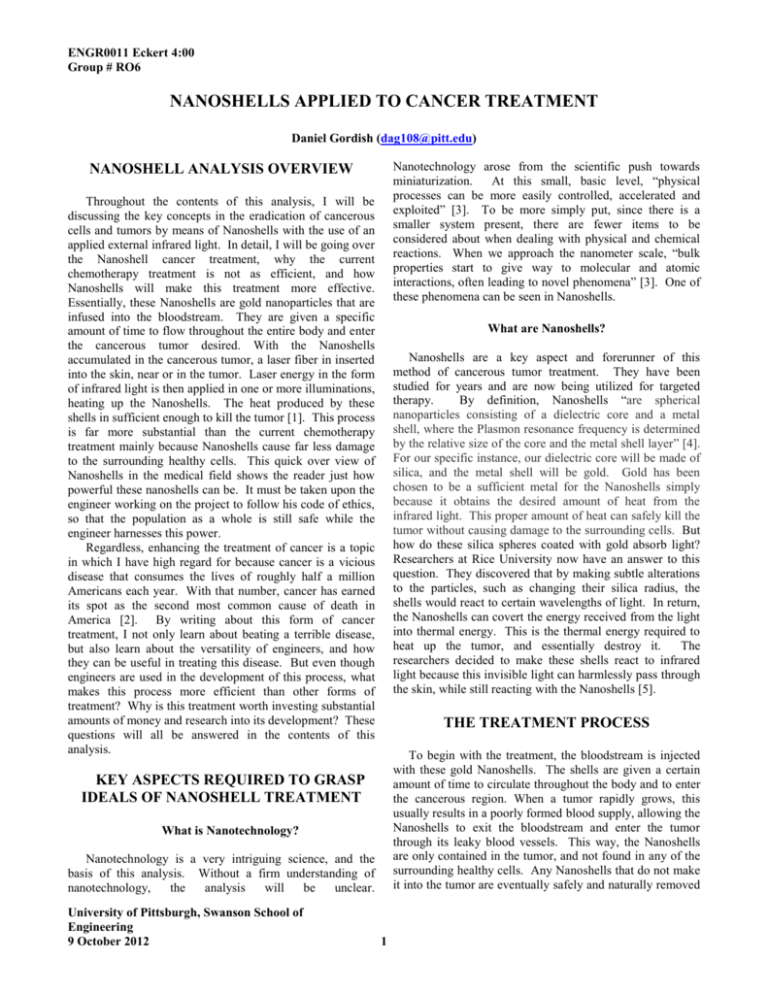
ENGR0011 Eckert 4:00 Group # RO6 NANOSHELLS APPLIED TO CANCER TREATMENT Daniel Gordish (dag108@pitt.edu) Nanotechnology arose from the scientific push towards miniaturization. At this small, basic level, “physical processes can be more easily controlled, accelerated and exploited” [3]. To be more simply put, since there is a smaller system present, there are fewer items to be considered about when dealing with physical and chemical reactions. When we approach the nanometer scale, “bulk properties start to give way to molecular and atomic interactions, often leading to novel phenomena” [3]. One of these phenomena can be seen in Nanoshells. NANOSHELL ANALYSIS OVERVIEW Throughout the contents of this analysis, I will be discussing the key concepts in the eradication of cancerous cells and tumors by means of Nanoshells with the use of an applied external infrared light. In detail, I will be going over the Nanoshell cancer treatment, why the current chemotherapy treatment is not as efficient, and how Nanoshells will make this treatment more effective. Essentially, these Nanoshells are gold nanoparticles that are infused into the bloodstream. They are given a specific amount of time to flow throughout the entire body and enter the cancerous tumor desired. With the Nanoshells accumulated in the cancerous tumor, a laser fiber in inserted into the skin, near or in the tumor. Laser energy in the form of infrared light is then applied in one or more illuminations, heating up the Nanoshells. The heat produced by these shells in sufficient enough to kill the tumor [1]. This process is far more substantial than the current chemotherapy treatment mainly because Nanoshells cause far less damage to the surrounding healthy cells. This quick over view of Nanoshells in the medical field shows the reader just how powerful these nanoshells can be. It must be taken upon the engineer working on the project to follow his code of ethics, so that the population as a whole is still safe while the engineer harnesses this power. Regardless, enhancing the treatment of cancer is a topic in which I have high regard for because cancer is a vicious disease that consumes the lives of roughly half a million Americans each year. With that number, cancer has earned its spot as the second most common cause of death in America [2]. By writing about this form of cancer treatment, I not only learn about beating a terrible disease, but also learn about the versatility of engineers, and how they can be useful in treating this disease. But even though engineers are used in the development of this process, what makes this process more efficient than other forms of treatment? Why is this treatment worth investing substantial amounts of money and research into its development? These questions will all be answered in the contents of this analysis. What are Nanoshells? Nanoshells are a key aspect and forerunner of this method of cancerous tumor treatment. They have been studied for years and are now being utilized for targeted therapy. By definition, Nanoshells “are spherical nanoparticles consisting of a dielectric core and a metal shell, where the Plasmon resonance frequency is determined by the relative size of the core and the metal shell layer” [4]. For our specific instance, our dielectric core will be made of silica, and the metal shell will be gold. Gold has been chosen to be a sufficient metal for the Nanoshells simply because it obtains the desired amount of heat from the infrared light. This proper amount of heat can safely kill the tumor without causing damage to the surrounding cells. But how do these silica spheres coated with gold absorb light? Researchers at Rice University now have an answer to this question. They discovered that by making subtle alterations to the particles, such as changing their silica radius, the shells would react to certain wavelengths of light. In return, the Nanoshells can covert the energy received from the light into thermal energy. This is the thermal energy required to heat up the tumor, and essentially destroy it. The researchers decided to make these shells react to infrared light because this invisible light can harmlessly pass through the skin, while still reacting with the Nanoshells [5]. THE TREATMENT PROCESS To begin with the treatment, the bloodstream is injected with these gold Nanoshells. The shells are given a certain amount of time to circulate throughout the body and to enter the cancerous region. When a tumor rapidly grows, this usually results in a poorly formed blood supply, allowing the Nanoshells to exit the bloodstream and enter the tumor through its leaky blood vessels. This way, the Nanoshells are only contained in the tumor, and not found in any of the surrounding healthy cells. Any Nanoshells that do not make it into the tumor are eventually safely and naturally removed KEY ASPECTS REQUIRED TO GRASP IDEALS OF NANOSHELL TREATMENT What is Nanotechnology? Nanotechnology is a very intriguing science, and the basis of this analysis. Without a firm understanding of nanotechnology, the analysis will be unclear. University of Pittsburgh, Swanson School of Engineering 9 October 2012 1 Daniel Gordish from the bloodstream by the liver. With the Nanoshells now abundant in the tumor, a laser fiber is inserted into the skin, and pushed into or around the tumor [1]. Infrared light is then emitted from the fiber in one or more illuminations, for about four to six minutes. The Nanoshells take in the infrared light energy, and convert this energy into heat. During the four to six minutes, the Nanoshells are able to heat up the tissue in the tumor to roughly 37 degrees Celsius more than its previous temperature. The healthy cells around the tumor that do not have the Nano shells inside of them only increased in temperature by a maximum value of 10 degrees Celsius, which is not enough heat to cause any permanent damage. The tissues heated with the Nanoshell particles displayed coagulation, cell shrinkage, and loss of nuclear staining, which are all indicators of irreversible thermal damage [5]. However, the healthy tissue surrounding the tumor remained unchanged. Afterwards, the dead tumor is reabsorbed into the body, and the treatment process is complete. This specificity and precision that is required in completing this cancer treatment is another reason why I choose to write about this issue. The Nanoshells used in this process is just one of many ways that nanotechnology will soon revolutionize our way of life. because the dangerous toxins used in chemotherapy are not present. THE OPPOSITION’S OPINION So far I have gone over all the positive effects that Nano shells bring to the medical field. However, there are some negative aspects that could affect our lives. One aspect involves privacy. As discussed by the nanoethics group, “As products shrink in size, eavesdropping devices too can become invisible to the naked eye and more mobile, making it easier to invade our privacy” [9]. They further go on to say, “small enough to plant into our bodies, mind-controlling nanodevices may be able to affect our thoughts by manipulating brain-processes” [9]. Different forms of terrorism may also arise from advances in nanotechnology. For example, “Nanotech may create new, unimaginable forms of torture – disassembling a person at the molecular level or worse” [9]. As we continue in the development of nanotechnology, we must remember that great power must come with great responsibility. WILL THE CODE OF ETHICS BE FOLLOWED IN FURTHER DEVELOPMENT? CURRENT TREATMENT Chemotherapy Code of Ethics for Engineers Chemotherapy is a common form of cancer treatment, in which toxins “are applied to the body in carefully controlled doses which are calculated to limit the growth of cancer cells while doing minimal damage to healthy body cells. However, since the main action of chemotherapeutic agents is to inhibit cell division, inevitably noncancerous cells are also affected and adverse side effects are common” [6]. Chemotherapy also does not always work. Studies have shown that cancer returns to the patients even after they went through chemotherapy and all of its negative side effects [7]. The reason the cancer returns is still unclear and is questioned by scientists. However, if Nanoshells would be used to fight the cancer, and it was to return, at least the patient has not gone through some or all of the devastating side effects of chemotherapy, which are explained below. The field of nanotechnology is a very intriguing and powerful field that could easily be altered to negatively affect the world’s population. As this field develops further and further, the engineers who enhance the technology will need to be extremely trusted by their peers. The code of ethics for all engineers specifically states that, “engineers are expected to exhibit the highest standards of honesty and integrity” [10]. An obvious breech in this honesty can occur in the third rule of practice, section c, which states that, “Engineers shall issue no statements, criticisms, or arguments on technical matters that are inspired or paid for by interested parties” [10]. A similar statement is also found in the fourth rule of practice, sections b and c, which state that, “Engineers shall not accept compensation, financial or otherwise, from more than one party for services on the same project, or for services pertaining to the same project,” and that, “Engineers shall not solicit or accept financial or other valuable consideration, directly or indirectly, from outside agents in connection with the work fro which they are responsible” [10]. Essentially, these statements are saying that an engineer who follows this code of ethics should never accept bribes from third parties wishing to obtain the secrets behind nanotechnology. These third parties could easily use this compelling technology against the human race, as a terrorist group or such. It is up to the engineer to decide whether he will honor his code of ethics, Chemotherapy side effects Some of the various side effects that can come from chemotherapy include fatigue, vomiting, gastrointestinal problems, oral problems, skin toxicity, alopecia, and eye problems [8]. All of these negative side effects are one of the main reasons I feel our cancer treatment should be better. The patient has already suffered enough from the disease: he should not need to deal with all these other debilitations. Although it has not been tested for, these types of problems would most likely not occur in the Nanoshell treatment 2 Daniel Gordish or cave to the demands of the group to make some easy money. Even though it is possible for this phenomenal technology to get into the hands of the wrong people, I still believe money should be invested into research. More good than bad will come from the producing and development of this technology, and there will always be bad people out there trying to do bad things, regardless of the situation at hand. saw before. For the most part, I always saw engineering as a person who solves problems involving physical structures and machines. I never imagined that an engineer would design ways to cure cancer. I also enjoyed writing about nanotechnology, especially the phenomenon that can occur on the nanometer scale. Nanotechnology is an intriguing study that I am now seriously considering getting into. Code of Ethics for Biomedical Engineering The use of Nanoshells in the treatment of cancer is an ongoing study that gets closer to being used in the field daily. As of right now, it has only been used on animals, but returns positive results. Once this treatment process enters the field, it will completely revolutionize cancer treatment by being more effective and efficient, while also containing no present negative side effects. As long as the engineers developing the Nanoshells keep their integrity as an engineer, nanotechnology will have no negative side effects, while are the side time completely revolutionize the process of treating cancer. By investing money and time into this treatment, the number of Americans killed by cancer will significantly drop, and cancer will no longer be known as such a devastating disease. Nanoshell Remarks Another code of ethics that the engineers working on nanotechnology should follow is the Biomedical Engineering Society Code of Ethics. This type of engineering “is a learned profession that combines expertise and responsibilities in engineering, science, technology, and medicine” [11]. Whenever the biomedical engineer is doing research about using Nanoshells to treat cancer, they must, “Comply fully with legal, ethical, institutional, governmental, and other applicable research guidelines, respecting the rights of and exercising the responsibilities to colleagues, human and animal subjects, and the scientific and general public” [11]. If the engineers are respectful and follow this code, ideally there should be no research toward hurting the wellbeing of anyone listed above. Therefore, you should just trust that the engineer would keep his integrity, and focus all of his research into the positive development of Nanoshells in the medical field. REFERENCES [1] Nanospectra, (2011). “Aurolase® Therapy.” Technology. (Online Article). http://www.nanospectra.com/technology/aurolasetherapy.ht ml [2] American Cancer Society, (2012). “How Many People Are Expected to Die of Cancer This Year?” Cancer Facts & Figures 2012. (Online Article). http://www.cancer.org/acs/groups/content/@epidemiologysu rveilance/documents/document/acspc-031941.pdf [3] A. DeMello, A. Woolley, (2010). “Nanotechnology.” Current Opinion in Chemical Biology. (Print Article). Vol. 14, Issue 5. Pages 545-547. [4] H. Xie, Z. Wang, A. Bao, B. Goins, W. Phillips, (2010). “Introduction.” International Journal of Pharmaceutics. (Print Article). Vol. 395, Issues 1-2. Pages 324-330. [5] L. Hirsch, R. Stafford, J. Bankson, S. Sershen, B. Rivera, R. Price, J. Hazle, N. Halas, J. West, (2003). “Abstract.” Nanoshell-mediated near-infrared thermal therapy of tumors under magnetic resonance guidance. (Online Article). http://www.pnas.org/content/100/23/13549.long [6] M. Clugston, (2009). “chemotherapy.” The Penguin Dictionary of Science. (Online article). http://www.credoreference.com/entry/penguinscience/chemo therapy [7] Red Orbit, (2012). “Why Chemotherapy Doesn’t Always Work.” Red Orbit. (Online Article). http://www.redorbit.com/news/health/1112543773/whychemotherapy-doesnt-always-work/ WHY NANOSHELLS ARE BETTER In this analysis, two forms of cancer treatment are recognized: the current chemotherapy treatment, and the modernized Nanoshell treatment. Both treatments have been found to eliminate and destroy cancerous tumors. However, with all the negative side effects chemotherapy has brought to the table, none of these side effects have been prominent in early Nanoshell treatment. Therefore, it is to be expected that this Nanoshell cancer treatment will be a more stable and suitable alternative to cancer treatment whenever it is fully understood and more often practiced. FINISHING REMARKS Educational Value: Was it worth it? Throughout the contents of this analysis, I have dedicated much time and effort into explaining the Nanoshell cancer treatment process, the current chemotherapy treatment, and the ethics that must be followed for these Nanoshells to be successful. Looking back on this analysis, I do believe this was worth every second of my time to write for a couple of reasons. The main reason I enjoyed writing this was that I got to see a diverse side of engineering that I never really 3 Daniel Gordish [8] S. Williamson, (2012). “Chemotherapy side effects.” General One File. (Online Article). http://go.galegroup.com.pitt.idm.oclc.org/ps/i.do?action=inte rpret&id=GALE%7CA298012751&v=2.1&u=upitt_main&i t=r&p=ITOF&sw=w&authCount=1 [9] The Nanoethics Group, (2008). “The bad” The Nanoethics Group. (Online Article). http://ethics.calpoly.edu/nanoethics/bad.html [10] National Society of Professional Engineers, (2012). “NSPE Code of Ethics for Engineers.” Code of Ethics. (Online Article). http://www.nspe.org/Ethics/CodeofEthics/index.html [11] (2004). “Biomedical Engineering Research Obligations”. Biomedical Engineering Society Code of Ethics. (Online Article). http://www.bmes.org/aws/BMES/asset_manager/get_file/19 110?ver=3480 ACKNOWLEDGEMENTS I acknowledge my friend Bradley Fulton, a Carnegie Mellon student, who interested me in the general topic of nanotechnology during our years as classmates. 4
